Temperature Regulation of Hot Vapor Preservation Treatment of Litchi Based on PSO-Fuzzy PID
Abstract
1. Introduction
2. Test Materials and Equipment
2.1. Test Material
2.2. Test Equipment Structure
2.3. Hot Vapor Temperature Control System
3. Principle of Particle Swarm Optimization Fuzzy PID Algorithm and Controller Design
3.1. Principle of Particle Swarm Optimization Algorithm
3.2. Fuzzy PID Control Principle
3.3. PSO-Fuzzy PID Controller Design
4. Analysis and Modeling of The Hot Vapor Treatment Process of Litchi
4.1. Equipment Preheating Link
4.2. Litchi Handling Link
4.2.1. Calculation of Heat Consumption of Litchi
4.2.2. Calculation of Heat Consumption of Conveyor Chain
5. System Testing and Discussion
5.1. Simulation Test
5.2. Equipment Load Test
- The temperature curve of the treatment time of 20 s is more stable than that of 30 s (a/b/e/f compared with c/d/g/h, respectively). From the data, the maximum temperature difference of the former is 1.665 °C on average, and the interference adjustment time is 48.5 s on average, which is smaller than the latter. This is because with the increase in treatment time, litchi absorbs more heat in the treatment chamber, resulting in a more obvious decrease in vapor temperature and a larger fluctuation range.
- The treatment temperature was set to 85 °C (a/b/c/d) and 80 °C (e/f/g/h), with the former curve having an average MTD of 1.75 °C and the latter at 1.97 °C. Additionally, the average IAT differed by 4.75 s, meaning that as the treatment temperature increased, the maximum temperature difference decreased and the control time became longer. It is worth noting that as the water vapor temperature increases, its specific heat capacity decreases gradually. For instance, the specific heat capacity of 80 °C water vapor is 3.414 J/(kg °C), while that of 85 °C water vapor is 2.832 J/(kg °C). Consequently, higher treatment temperatures result in smaller specific heat of water vapor and slower heat dissipation, leading to a decrease in MTD value and an increase in IAT value.
- When using the Fuzzy PID method (a/c/e/g), the maximum temperature difference typically exceeds 2 °C, with an average of 2.14 °C, and the average IAT is approximately 55.75 s. After using the PSO-Fuzzy PID method (b/d/f/h), both indices for each treatment parameter combination decreased, with an average reduction of 0.56 °C in MTD and 7.5 s in IAT. This proves that the fuzzy PID control optimized by particle swarm optimization can effectively reduce the temperature fluctuation of the processing room during litchi processing, shorten the adjustment time, and enable the system to better maintain a stable processing temperature.
6. Conclusions
Author Contributions
Funding
Institutional Review Board Statement
Informed Consent Statement
Data Availability Statement
Conflicts of Interest
References
- Su, Z.X.; Yang, S.N.; Chen, H.B.; Shen, J.Y. Analysis of the production situation for litchi in main planting areas of China in 2020. South. Agric. J. 2020, 51, 1598–1605. (In Chinese) [Google Scholar]
- Jiang, Y.; Ai, J.W.; Wang, L.L. Research Progress on Postharvest Preservation Technology of Tropical Fruit Litchi and Longan. Agric. Prod. Process. 2016, 63–66. (In Chinese) [Google Scholar] [CrossRef]
- Sivakumar, D.; Korsten, L. 15—Litchi (Litchi chinensis Sonn.). In Postharvest Biology and Technology of Tropical and Sub-Tropical Fruits; Yahia, E.M., Ed.; Woodhead Publishing: Solston, UK, 2011; pp. 361–409. [Google Scholar] [CrossRef]
- Fang, F.; Zhang, Z.; Zhang, X.; Wu, Z.; Yin, H.; Pang, X. Reduction in activity/gene expression of anthocyanin degradation enzymes in lychee pericarp is responsible for the color protection of the fruit by heat and acid treatment. J. Integr. Agric. 2013, 12, 1694–1702. [Google Scholar] [CrossRef]
- Jiang, Y.M.; Wang, Y.; Song, L.; Liu, H.; Lichter, A.; Kerdchoechuen, O.; Joyce, D.C.; Shi, J. Postharvest characteristics and handling of litchi fruit—An overview. Aust. J. Exp. Agric. 2006, 46, 1541–1556. [Google Scholar] [CrossRef]
- Castañeda-Miranda, A.; Castaño-Meneses, V.M. Internet of things for smart farming and frost intelligent control in greenhouses. Comput. Electron. Agric. 2020, 176, 105614. [Google Scholar] [CrossRef]
- Deb, K.; Pratap, A.; Agarwal, S.; Meyarivan, T. A fast and elitist multiobjective genetic algorithm: NSGA-II. Evolutionary Computation. IEEE Trans. 2002, 6, 182–197. [Google Scholar] [CrossRef]
- Lambora, A.; Gupta, K.; Chopra, K. Genetic algorithm-A literature review. In Proceedings of the 2019 International Conference on Machine Learning, Big Data, Cloud and Parallel Computing (COMITCon), Faridabad, India, 14–16 February 2019; pp. 380–384. [Google Scholar] [CrossRef]
- Wang, C.; Liu, R.; Tang, A. Energy management strategy of hybrid energy storage system for electric vehicles based on ge-netic algorithm optimization and temperature effect. J. Energy Storage 2022, 51, 104314. [Google Scholar] [CrossRef]
- Jain, M.; Saihjpal, V.; Singh, N.; Singh, S.B. An Overview of Variants and Advancements of PSO Algorithm. Appl. Sci. 2022, 12, 8392. [Google Scholar] [CrossRef]
- Guo, Y.; Zhao, H.J.; Zhang, S.H.; Wang, Y.; Chow, D. Modeling and optimization of environment in agricultural greenhouses for improving cleaner and sustainable crop production. J. Clean. Prod. 2021, 285, 124843. [Google Scholar] [CrossRef]
- Gavrilovic, N.; Sibalija, T.; Domazet, D. Design and implementation of discrete Jaya and discrete PSO algorithms for auto-matic collaborative learning group composition in an e-learning system. Appl. Soft. Comput. 2022, 129, 109611. [Google Scholar] [CrossRef]
- Dorigo, M.; Stützle, T. Ant Colony Optimization: Overview and Recent Advances; Springer: Berlin/Heidelberg, Germany, 2019. [Google Scholar] [CrossRef]
- Montalvo, W.; Guanochanga, D.; Chapaca, J. I+ PD Temperature Controller Tuned for Ant Colony Optimization (ACO) on an ARM Platform. In Communication, Smart Technologies and Innovation for Society; Springer: Berlin/Heidelberg, Germany, 2022; pp. 229–239. [Google Scholar] [CrossRef]
- Jia, Y. Research on Human-simulated Intelligent Control based on Genetic Optimization in Temperature Control System. New Technol. New Process 2015, 106–109. (In Chinese) [Google Scholar] [CrossRef]
- Ning, K.W.; Li, M.H. Control Parameter Tuning Based on Genetic Algorithm and Its Application in Temperature Control. Packag. Eng. 2016, 37, 141–145. (In Chinese) [Google Scholar] [CrossRef]
- Saini, S.; Rani, S. Temperature Control Using Intelligent Techniques. In Proceedings of the 2012 Second International Conference on Advanced Computing & Communication Technologies, Rohtak, India, 7–8 January 2012. [Google Scholar] [CrossRef]
- Naveenkumar, K.S.; Visalakshi, S. Optimization based on PSO-ANFIS in Water bath Temperature System. Int. J. Innov. Res. Comput. Commun. Eng. 2014, 2, 32–37. [Google Scholar]
- Adnan, R.; Tajjudin, M.; Ishak, N.; Ismail, H.; Rahiman, M.H.F.; Arshad, N.M. Comparison between self-tuning Fuzzy-PID and Pole-Placement PID with application to saturated steam temperature regulation. In Proceedings of the 2012 International Conference on System Engineering and Technology (ICSET), Bandung, Indonesia, 11–12 September 2012. [Google Scholar] [CrossRef]
- Gouadria, F.; Sbita, L.; Sigrimis, N. A greenhouse system control based on a PSO tuned PI regulator. In Proceedings of the 2017 International Conference on Green Energy Conversion Systems (GECS), Hammamet, Tunisia, 23–25 March 2017; pp. 1–5. [Google Scholar] [CrossRef]
- Dorrah, H.T.; El-Garhy, A.M.; El-Shimy, M.E. PSO based optimized fuzzy controllers for decoupled highly interacted distilla-tion process. Ain. Shams. Eng. J. 2012, 3, 251–266. [Google Scholar] [CrossRef]
- Ambroziak, A.; Chojecki, A. The PID controller optimisation module using Fuzzy Self-Tuning PSO for Air Handling Unit in continuous operation. Eng. Appl. Artif. Intell. 2023, 117, 105485. [Google Scholar] [CrossRef]
- Chen, Y.; Cai, W.; Zou, X.; Xiang, H.; Liu, T.; Xu, F. Mechanical properties test and finite element analysis for litchi. Trans. Chin. Soc. Agric. Eng. 2011, 27, 358–363. [Google Scholar] [CrossRef]
- Li, F.; Liu, Y.T.; Wang, X.H.; Li, H.L.; Wang, G.; Wang, J.B. Dynamic observation on fruit growth and devel-opment of two litchi varieties. Sci. Trop. Agric. 2021, 41, 27–33. (In Chinese) [Google Scholar]
- Borase, R.P.; Maghade, D.K.; Sondkar, S.Y.; Pawar, S.N. A review of PID control, tuning methods and applications. Int. J. Dyn. Control 2021, 9, 818–827. [Google Scholar] [CrossRef]
- Wang, H. Main steam temperature control system based on fuzzy control scheme. In Proceedings of the 2014 Sixth International Conference on Intelligent Human-Machine Systems and Cybernetics, Hangzhou, China, 26–27 August 2014; pp. 93–95. [Google Scholar] [CrossRef]
- Lin, H.; Cao, B.; Liao, Y.; Lin, H.; Cao, B.; Liao, Y. Fuzzy Control. Fuzzy Sets Theory Preliminary: Can a Washing Machine Think? Springer: Berlin/Heidelberg, Germany, 2018; pp. 73–108. [Google Scholar] [CrossRef]
- Choudhary, S.; Sugumaran, S.; Belazi, A.; El-Latif, A.A.A. Linearly decreasing inertia weight PSO and improved weight fac-tor-based clustering algorithm for wireless sensor networks. J. Amb. Intel. Hum. Comp. 2021, 14, 6661–6679. [Google Scholar] [CrossRef]
- Silva, G.J.; Datta, A.; Bhattachaiyya, S.P. PID Stabilization of First-Order Systems with Time Delay. In PID Controllers for Time-Delay Systems; Springer: Berlin/Heidelberg, Germany, 2005; pp. 161–190. [Google Scholar] [CrossRef]
- Ding, Y.X.; Zhang, N.; Chen, A.Q. Analysis of heat transfer characteristics of postitive fruits and vegetables under heat treatment conditions. Food Ferment. Ind. 2020, 46, 188–193. (In Chinese) [Google Scholar] [CrossRef]
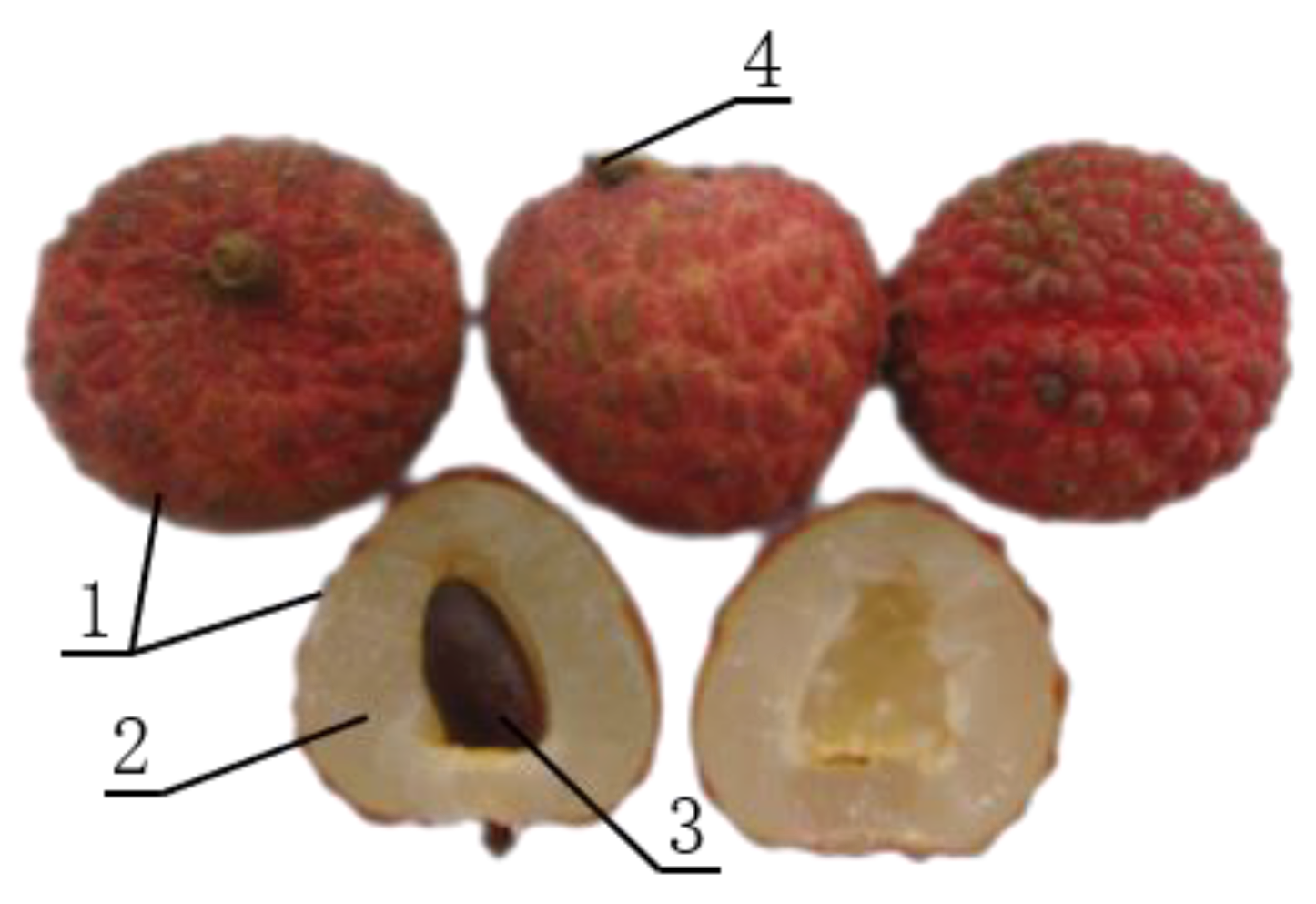
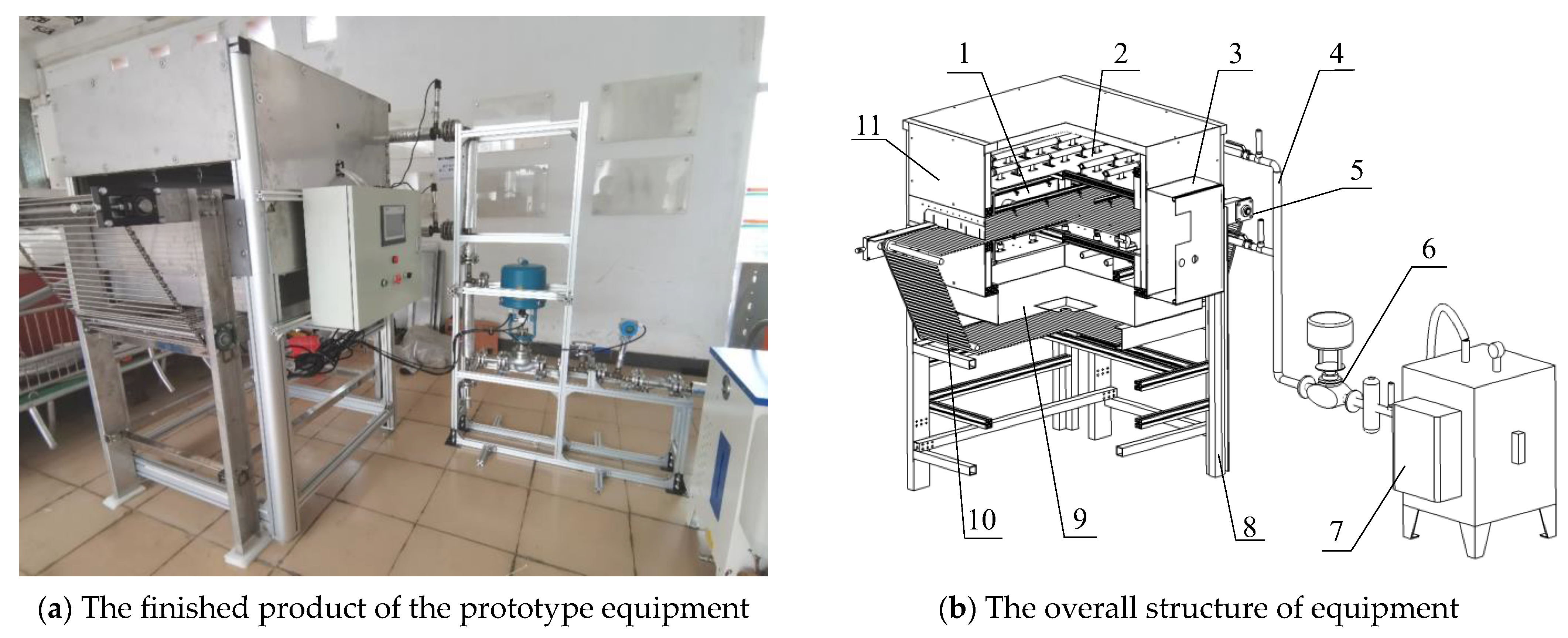
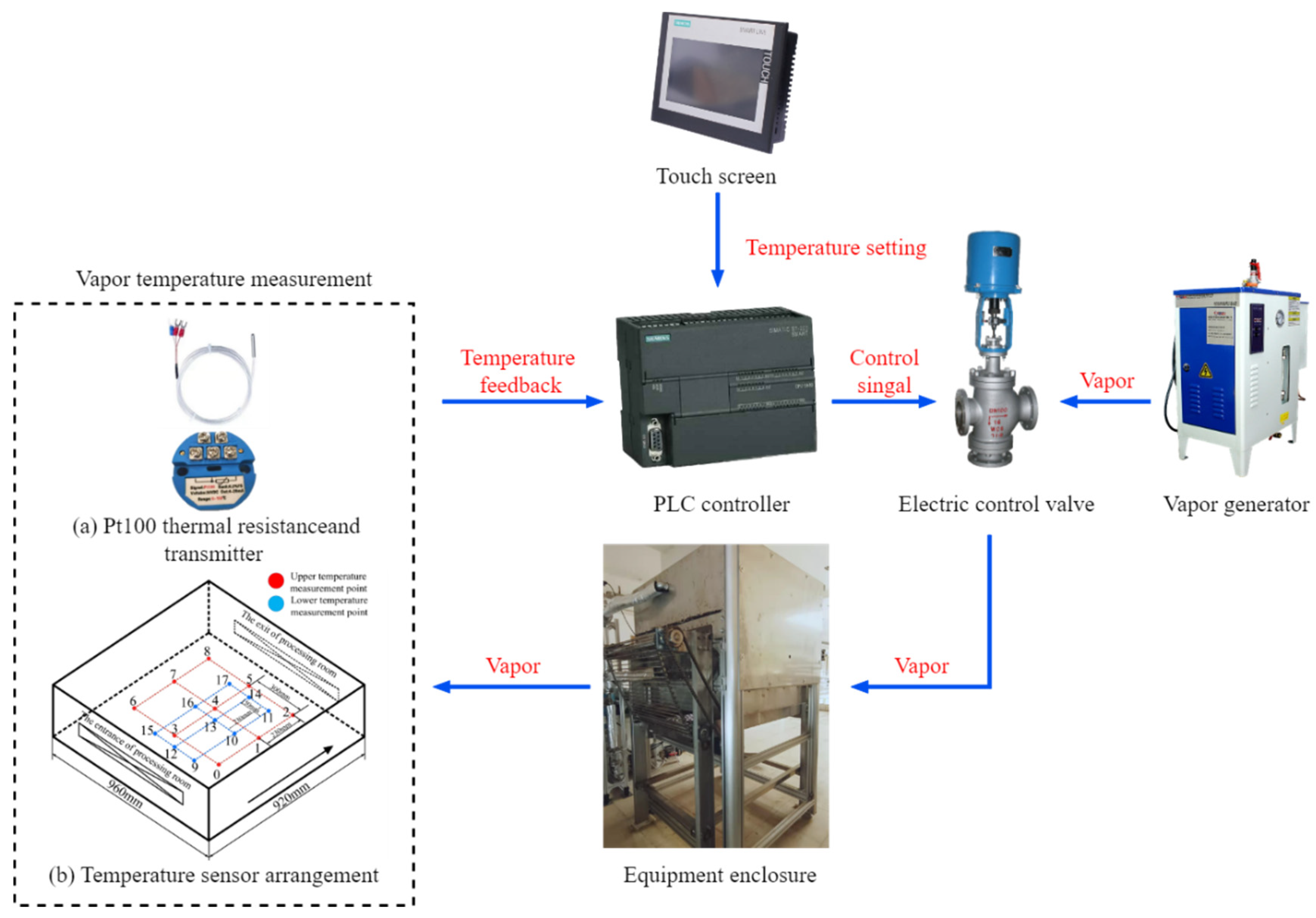


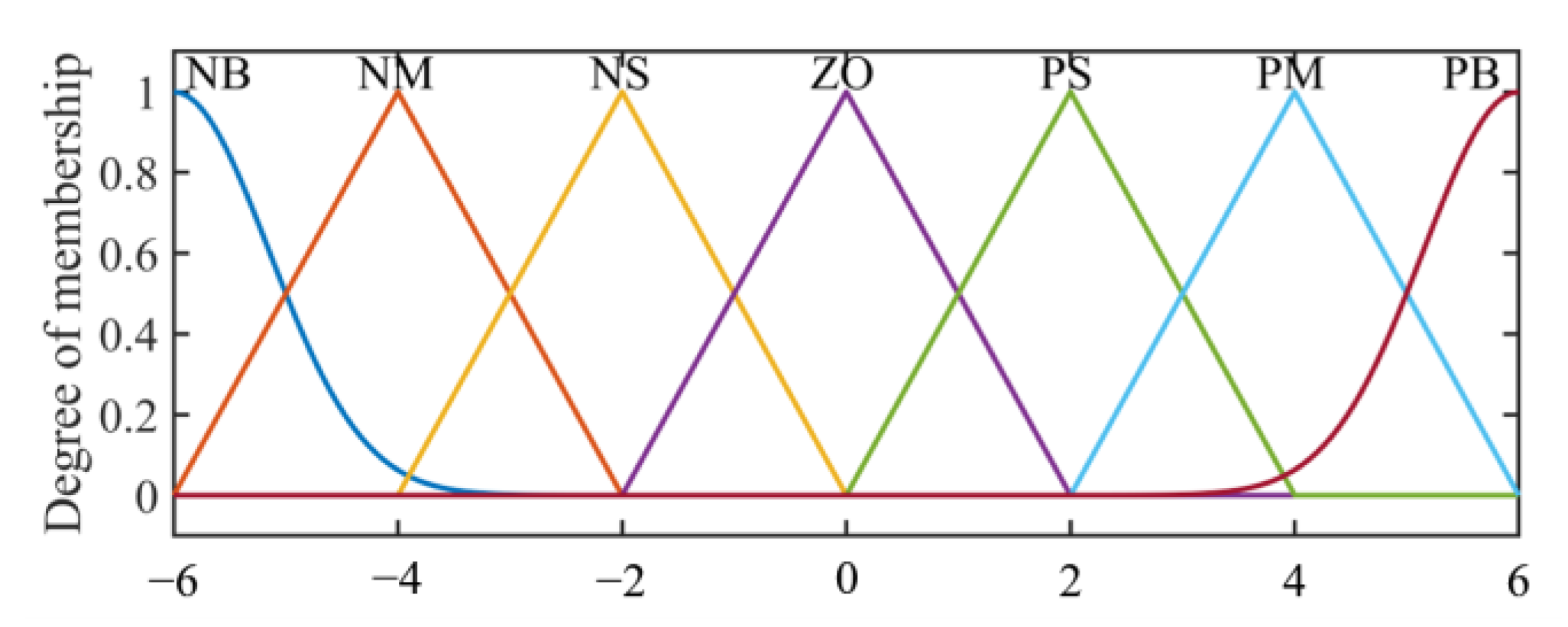
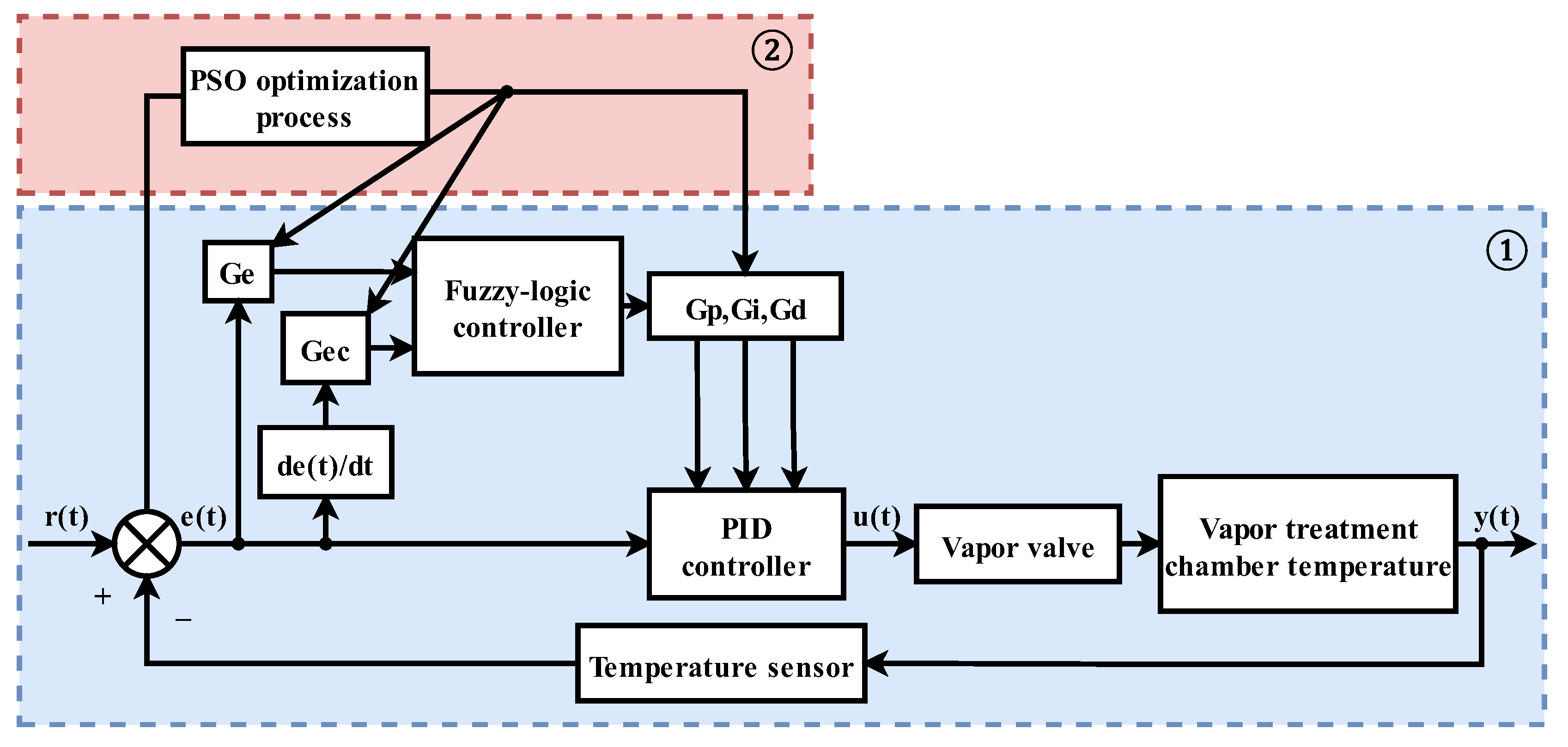
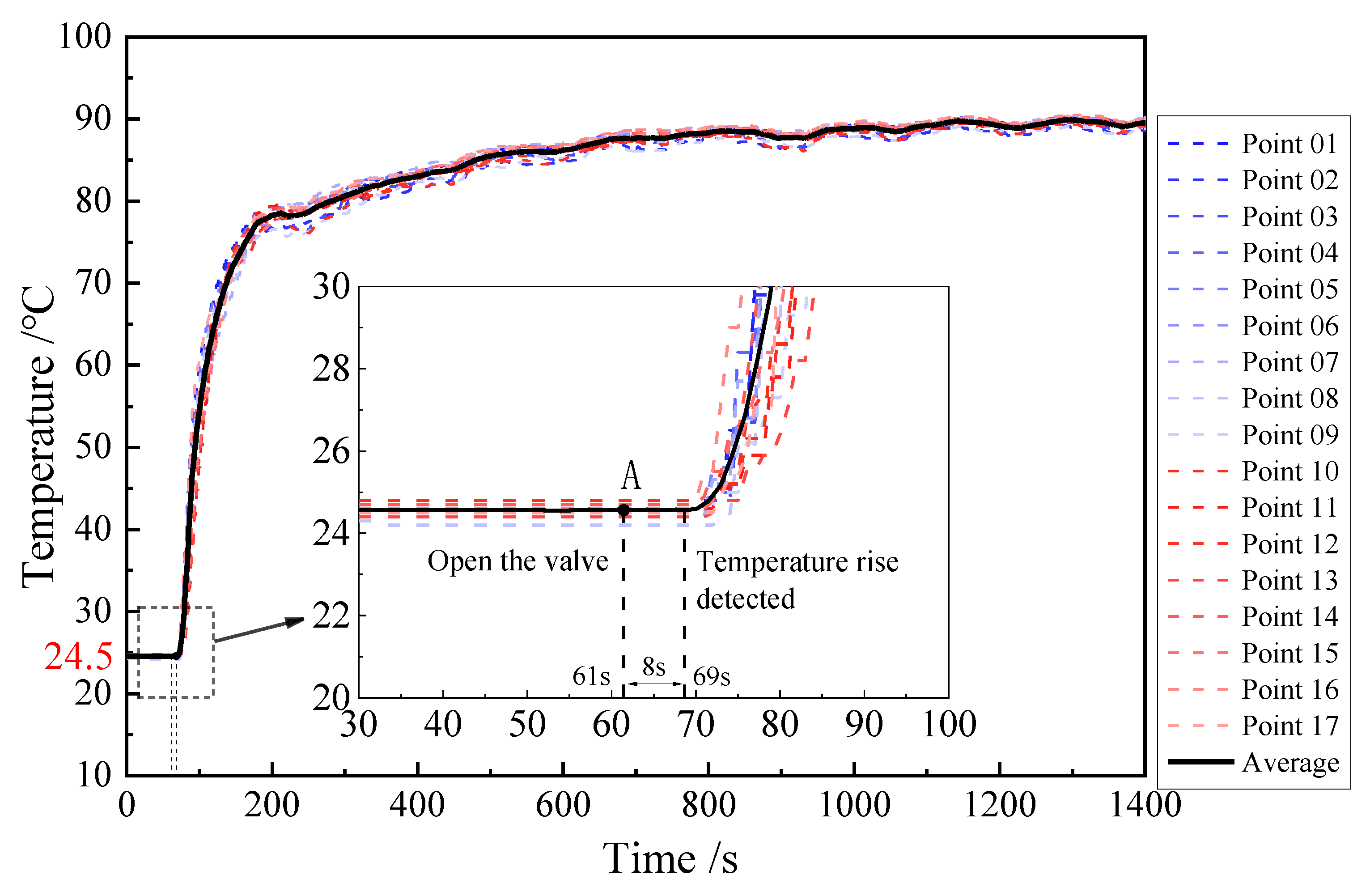


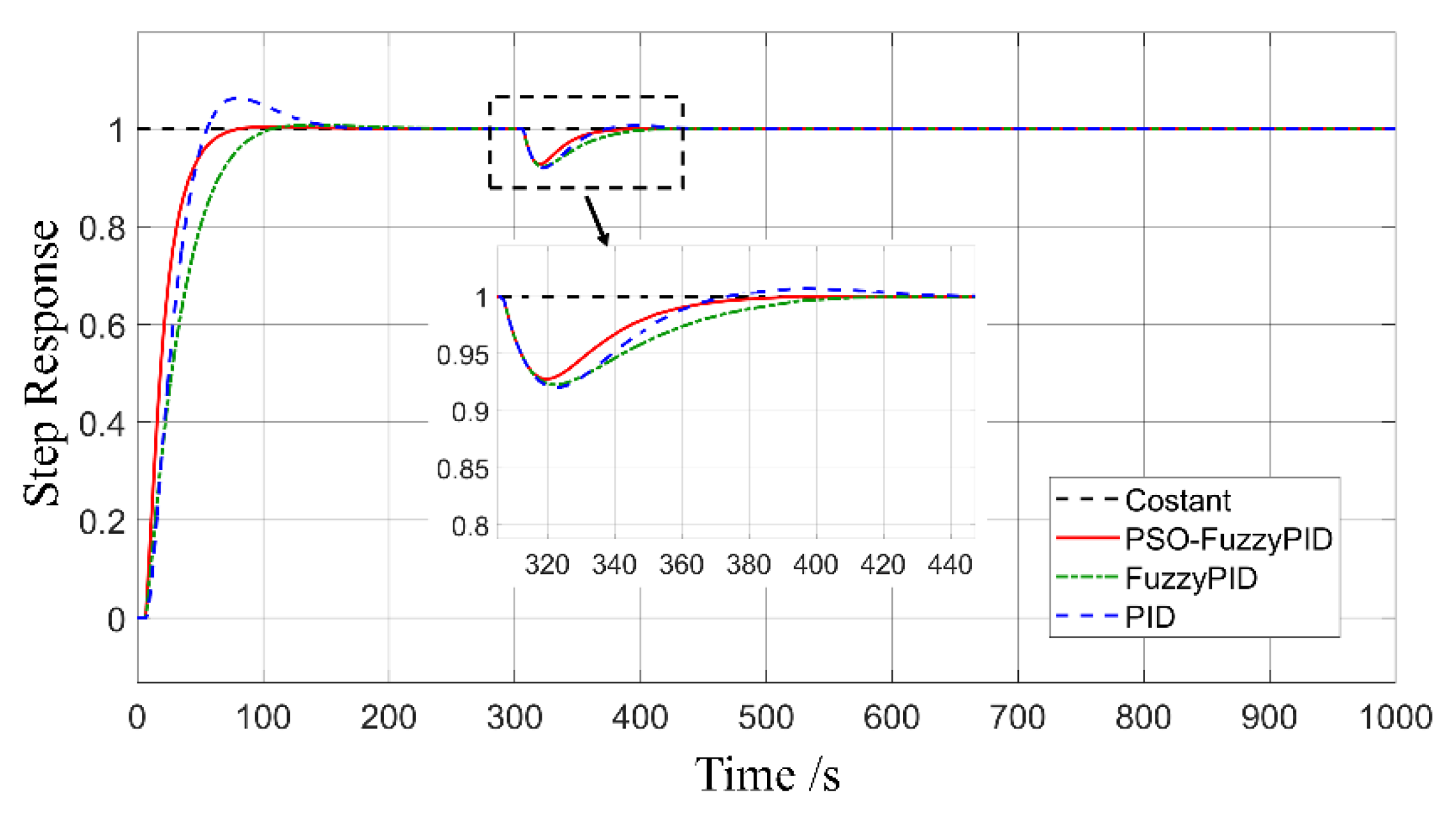
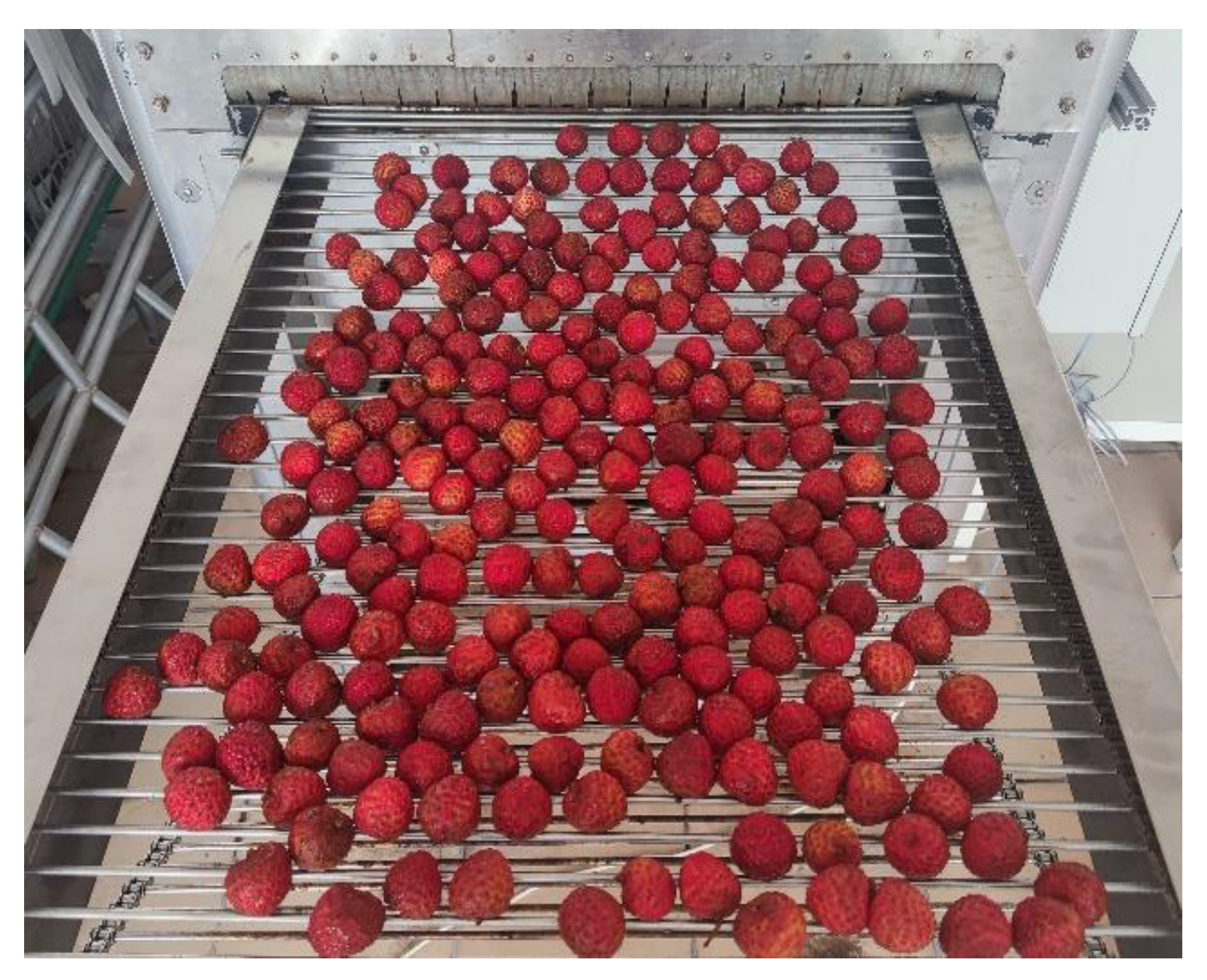
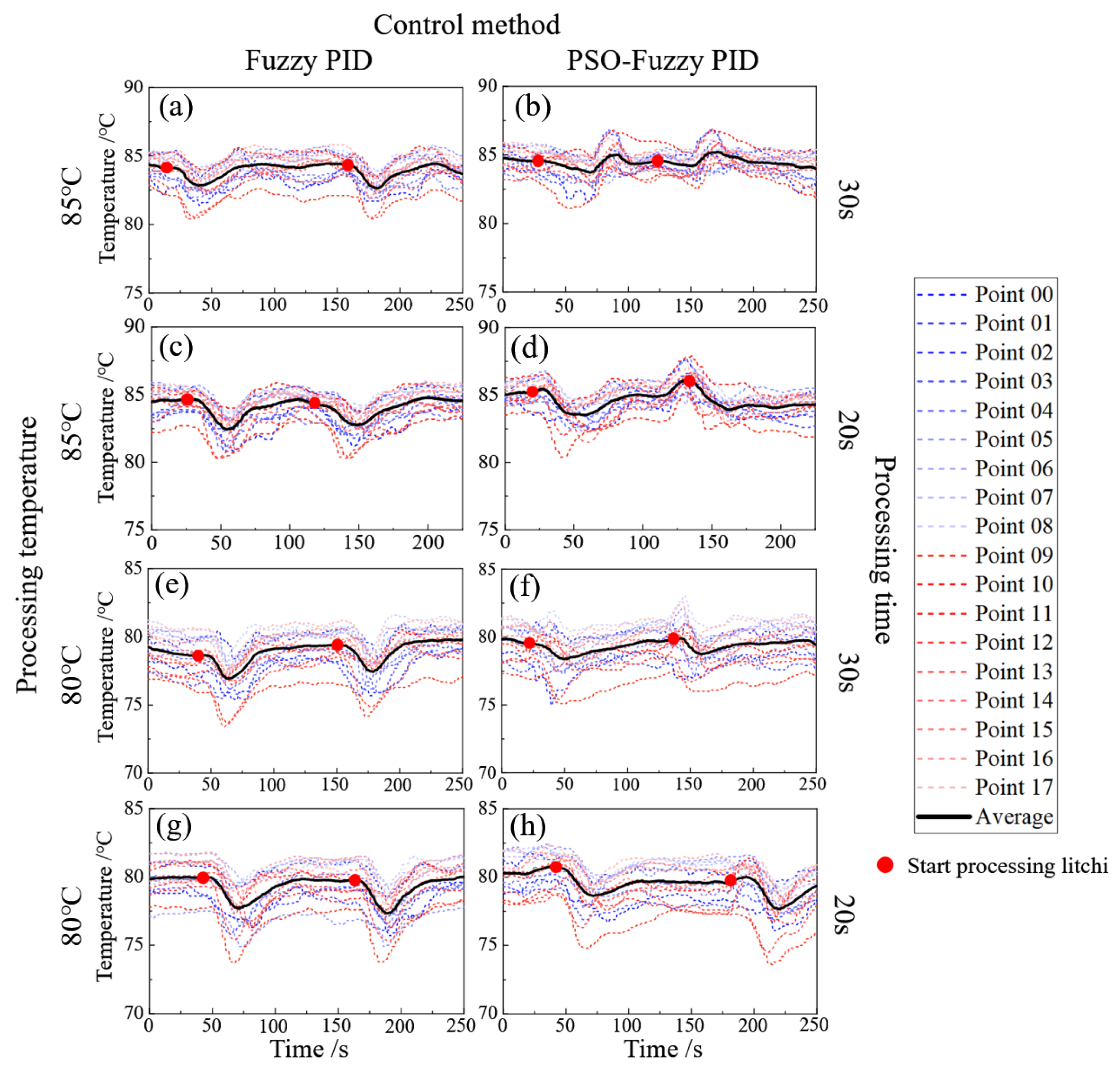
| Error | Error Rate | ||||||
|---|---|---|---|---|---|---|---|
| NB | NM | NS | ZO | PS | PM | PB | |
| NB | PB/PS/NB | PB/NS/NB | PM/NB/NM | PM/NB/NM | PS/NB/NS | ZO/NM/ZO | ZO/PS/ZO |
| NM | PB/PS/NB | PB/NS/NB | PM/NB/NM | PS/NM/NS | PS/NM/NS | ZO/NS/ZO | NS/ZO/ZO |
| NS | PM/ZO/NB | PM/NS/NM | PM/NM/NS | PS/NM/NS | ZO/NS/ZO | NS/NS/NS | NS/ZO/PS |
| ZO | PM/ZO/NM | PM/NS/NM | PS/NS/NS | ZO/NS/ZO | NS/NS/PS | NM/NS/PM | NM/ZO/PM |
| PS | PS/ZO/NM | PS/ZO/NS | ZO/ZO/ZO | NS/ZO/PS | NS/ZO/PS | NM/ZO/PM | NM/ZO/PB |
| PM | PS/PB/ZO | ZO/PS/ZO | NS/PS/PS | NM/PS/PS | NM/PS/PM | NM/PS/PB | NB/PB/PB |
| PB | ZO/PB/ZO | ZO/PM/ZO | NM/PM/PS | NM/PM/PM | NM/PS/PM | NB/PS/PB | NB/PB/PB |
| Sample Time/s | Temperature Value/°C | ||||||
|---|---|---|---|---|---|---|---|
| 0 | 958 | 19.2 | 44 | 24.5 | 90 | 42.84 | 65.9 |
| Single Mass/g | Average Peel Thickness/mm | Equivalent Ball Diameter/mm | ||
|---|---|---|---|---|
| 20~25 | 1~1.5 | 19~31 | 932.89 | 3710 |
| Control Method | Overshoot/% | Rise Time/s | IAT/s |
|---|---|---|---|
| PID | 6.2 | 56 | 150 |
| Fuzzy PID | 0.7 | 104 | 116 |
| PSO-Fuzzy PID | 0.4 | 76 | 81 |
| Test Groups | Processing Temperature/°C | Processing Time/s | Control Method |
|---|---|---|---|
| a | 85 | 20 | Fuzzy PID |
| b | 85 | 20 | PSO-Fuzzy PID |
| c | 85 | 30 | Fuzzy PID |
| d | 85 | 30 | PSO-Fuzzy PID |
| e | 80 | 20 | Fuzzy PID |
| f | 80 | 20 | PSO-Fuzzy PID |
| g | 80 | 30 | Fuzzy PID |
| h | 80 | 30 | PSO-Fuzzy PID |
| Evaluation Indicators | Test Groups | |||||||
|---|---|---|---|---|---|---|---|---|
| a | b | c | d | e | f | g | h | |
| MTD/ °C | 1.69 | 1.19 | 2.37 | 1.75 | 2.23 | 1.55 | 2.27 | 1.83 |
| IAT/s | 53 | 49 | 54 | 42.5 | 48 | 44 | 68 | 57.5 |
| Evaluation Indicators | Processing Parameters | Control Method | ||||
|---|---|---|---|---|---|---|
| 20 s (a/b/e/f) | 30 s (c/d/g/h) | 80 °C (e/f/g/h) | 85 °C (a/b/c/d) | Fuzzy PID (a/c/e/g) | PSO-Fuzzy PID (b/d/f/h) | |
| MTD (Average)/°C | 1.665 | 2.055 | 1.97 | 1.75 | 2.14 | 1.58 |
| IAT (Average)/s | 48.5 | 55.5 | 54.375 | 49.625 | 55.75 | 48.25 |
Disclaimer/Publisher’s Note: The statements, opinions and data contained in all publications are solely those of the individual author(s) and contributor(s) and not of MDPI and/or the editor(s). MDPI and/or the editor(s) disclaim responsibility for any injury to people or property resulting from any ideas, methods, instructions or products referred to in the content. |
© 2023 by the authors. Licensee MDPI, Basel, Switzerland. This article is an open access article distributed under the terms and conditions of the Creative Commons Attribution (CC BY) license (https://creativecommons.org/licenses/by/4.0/).
Share and Cite
Tang, H.; Ma, R.; Chen, Y.; Huang, L.; Jiao, R. Temperature Regulation of Hot Vapor Preservation Treatment of Litchi Based on PSO-Fuzzy PID. Appl. Sci. 2023, 13, 6888. https://doi.org/10.3390/app13126888
Tang H, Ma R, Chen Y, Huang L, Jiao R. Temperature Regulation of Hot Vapor Preservation Treatment of Litchi Based on PSO-Fuzzy PID. Applied Sciences. 2023; 13(12):6888. https://doi.org/10.3390/app13126888
Chicago/Turabian StyleTang, Hao, Ruijun Ma, Yu Chen, Li Huang, and Rui Jiao. 2023. "Temperature Regulation of Hot Vapor Preservation Treatment of Litchi Based on PSO-Fuzzy PID" Applied Sciences 13, no. 12: 6888. https://doi.org/10.3390/app13126888
APA StyleTang, H., Ma, R., Chen, Y., Huang, L., & Jiao, R. (2023). Temperature Regulation of Hot Vapor Preservation Treatment of Litchi Based on PSO-Fuzzy PID. Applied Sciences, 13(12), 6888. https://doi.org/10.3390/app13126888






